Capturing the passion: Refreshing BBC Sport user personas
Christine Charnock
User Experience Designer
When starting a new project as a designer, it can be very tempting to go straight to the visual design stage - thrashing out lots of ideas and then getting straight into the fine details of what the product will look like and how it might behave. But as we’re doing this, do we really know who are users are and if what we’re designing fulfils their needs? If not, it’s like designing in the dark. We might think we know who’s looking at our websites and apps, but do we actually know what their behaviours and motivations are for using what we make?
At the BBC we look to you (our audience) to shape how and what we make. We use many different methods and tools to help with this. The tool I’m going to talk about is a set of Personas.
When we started thinking about the future of BBC Sport after the amazing Summer of events last year, there was one question that kept being asked: “Are our personas still relevant?”.
Along with my colleagues Genine Keogh and Lizzie Dyson, we were tasked with revisiting and refreshing the existing BBC Sport personas. Capturing the diversity and enthusiasm of our current users would be an engaging way to help design and shape the future of BBC Sport.
The journey of creating personas was a long process, which is also reflected in the length of this blog post. However, the whole process was exciting and interesting, and something that we really wanted to share.
What is a persona?
A persona is a fictional person whose story and behaviours are generated from user research. Each persona is representative of a group of real users. As each persona story is short, snappy and memorable, it helps us as a team to build and design for a variety of people - rather than making something for one type of person.
We know that there’s an industry split on the effectiveness of personas. One view is that personas are a useful tool to help inform creative decisions, ensuring that designers are designing for the audience and not just themselves. Another view is that personas are fictitious and don’t emulate real people – meaning that any designs would be created for a person that doesn’t exist.
At the BBC, we think that personas are a really useful tool to help designers. We do lots of audience research and collating these findings into a persona story is much easier to imagine and remember. Personas help us to understand and relate to our audience and to design experiences that appeal to them.
Assessing the existing personas
The personas that we had to revisit were created back in 2010 – a time when mobile and tablet devices weren't as heavily used in the daily lives of BBC Sport users. When we read through the old personas, we realised that so much had changed with technology usage and uptake over the past four years.
We also thought that the personas didn’t tell much of a story – you couldn’t really feel or understand the persona’s daily habits or sporting passions. We decided that we needed to create personas that you could actually strike up a conversation with if they were real.
We needed to assess the old personas in depth. By sticking these old persona profiles up on a wall, we were able to write different thoughts and ideas onto each one, challenging and questioning everything. There were things that we assumed would still be relevant today, but also statements that we didn’t agree with. To answer these questions and assumptions, we needed to talk to real users again.
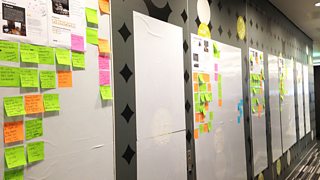
Starting the wall of post-it notes
Talking to real users: Part 1
From looking at the questions and notes that we had generated on the old personas, we knew that we needed to chat to real people about how they use BBC Sport and follow sport in general. Would these old personas map to how people behave and follow sport today?
To start this process, informal chats were set up with staff within the BBC that had an interest in sport and used the BBC Sport website or apps. Whether it was someone who was solely passionate about football, to someone who would just follow big events such as the Olympics, we wanted to talk to a diverse range of sport followers. Using an internal mail out, we called out to those who had an interest in sport and who used BBC Sport services in some way. However, we aimed to screen out those who had worked on Sport or had a technical or design background. We really wanted to meet staff working elsewhere in the BBC.
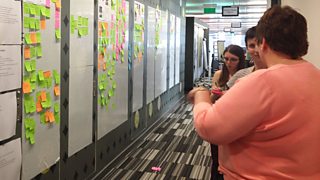
Interviewing a member of staff
Every discussion that we had with staff members was recorded and comments written onto post-it notes. We began to stick these interesting observations, comments and quotes onto the wall, placing them against old personas if they matched, and clustering together new topics and ideas.
Speaking to a variety of people was inspiring and informative – and I was always trying to scribble down exciting findings and their insightful quotes onto post-it notes. It was fascinating to find out how so many people could use and interpret the BBC Sport website in different ways.
Digesting details
After we had spoken to around 20 staff members, we found that we had a massive amount of written data in the form of post-it notes. We grouped these together into themes, and began to form questions from these new findings. Using this first set of themes, we could then find people with all kinds of interests in sport from outside the BBC to come and talk to us.
Using our own staff was a quick and cheap way to help us identify themes that we could focus on in the next stage of interviewing with our audience.
Talking to real users: Part 2
Getting some information from staff was really useful, but we really needed to understand what the audience thought and get a diverse outlook. We recruited eight members of the public, and held “depth interviews” over two days. Each participant had a differing interest in sport, and each used BBC Sport services in some way to follow their sport or team and to find out information.
As the interviews lasted between 45-60 minutes, we made sure we prepared well to get the most from them. Firstly, we created a discussion guide (or script) with a series of questions and topics to ask each person. It was important that the discussion guide was flexible, allowing the interview to flow freely and adapt to the person’s usage and interest of BBC Sport.
As well as questions, we planned a card sorting and ranking exercise to find out which sports the person did and didn’t like. And lastly, around the interview room walls, we printed out and stuck a series of BBC Sport website and mobile app screenshots. Allowing the participant to look over these and make comments on specific pages that they used and didn’t use was extremely valuable, and raised further discussion points in the depth interview.
Every session was observed by a range of staff including UX, Development, Editorial, Marketing & Audiences and Product - everyone involved in building the products. We asked everyone to write down their three key takeaways from the interview they observed, and to discuss these at the end.

Observers of a depth interview
Recordings and transcripts were taken of each interview, allowing us to go back through, pick out the facts and reference interesting points made.
Using research findings to create persona stories
From the staff interviews and depth interviews with the public, we had accumulated a vast amount of valuable data.
We added the extra information that we’d collected from the depth interviews to the (ever-growing) wall of insights. On first look, all the data felt overwhelming. To overcome this, we yet again grouped facts and findings together into themes, ensuring that we were streamlining to the most relevant and important information. We then used these themes and facts to start generating draft stories and skeleton personas. From the research, we felt that there were five different kinds of users that would allow us to create a persona profile for each.
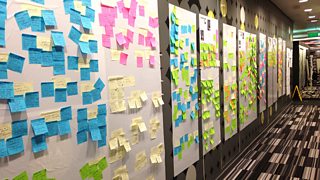
The growing wall of post-it notes
We knew that condensing this vast amount of data into short, engaging narratives was going to be tricky, and that we would have to do many re-edits of stories to get them to a memorable and digestible stage. Genine, Lizzie and I worked on a persona each. We started by writing the stories in a step-by-step manner on a series of post-it notes, and then typing these up and condensing further.
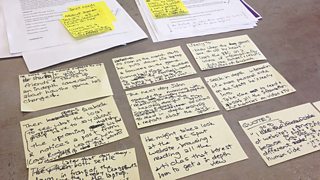
Initial phase of creating persona stories
The narrative approach that worked best was a ‘day in the life of…’ style. It depicted the person’s interactions with sport throughout the day, and detailed their behaviours and device usage.
Rearranging stories
The draft persona stories that we initially created were far too long – spanning pages of A4 each. So, to get a good overall view, we printed them out, cut out the individual sentences, and laid them out side by side. We were easily able to see what was important to the story, and what we could take out – rearranging and editing the stories in a really quick, simple and hands-on way.
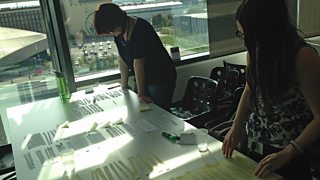
Rearranging persona stories
Once we’d done this, we compiled the stories again and let the rest of the Sport UX team have a read through to sense-check what we’d created. Was there anything that didn’t make sense? Had we included all the important information? Was this going to be usable and inspiring for designers? Have we depicted how diverse our audience is?
Persona Naming Ceremony
After the stories were checked, finalised and completed, they were transformed into posters – a large detailed poster and a smaller ‘quick-look’ summary poster. Everything but a name and photograph was included.
We invited a range of staff from UX, Editorial and Product to come to an official ‘Persona Naming Ceremony’.
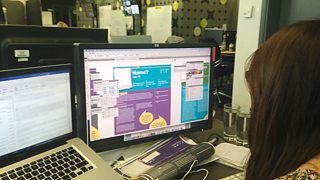
Creating persona posters
All the attendees were split into five groups, one group per persona. Each group read through the stories with the blanks, discussed and decided on a name for the persona, and then the persona story was read out to everyone with its brand new name.
This naming ceremony gave a sense of ownership and really brought the personas to life.
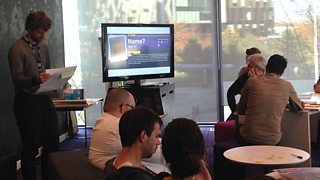
The Naming Ceremony
How does all this help?
Although we have audience segments created by our colleagues in Audiences that give us quantitative data on our audience, personas are a great design tool to think about a single user and how they would engage in BBC Sport.
The updated and fresh BBC Sport personas make it much easier for designers to imagine who they are designing for. Scouring over lots of research documents can become overwhelming, and it’s easy to get mixed up on which groups of people use particular devices or have certain behaviours. These personas are catchy, simple and memorable, allowing designers to keep them in their thoughts throughout every design process.
Although personas are primarily a UX tool, they are hugely helpful to everyone – Product Management, Development, Editorial and beyond.
What’s next?
We’re really excited to use the personas and make them as visible as possible to everyone. As well as putting up posters, we’re making web versions of the personas so they are easily accessible to all Sport staff.
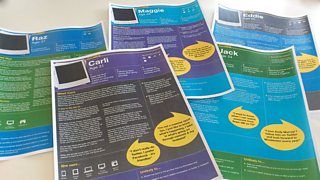
Persona posters
We use personas in creative workshops to ensure that what we’re designing meets the needs of our audience.
The BBC Sport personas will always be updating and evolving. We’re constantly speaking to our audience, and this helps us to validate the existing research that we’ve got.
We want to ensure these personas are a part of the everyday. Most of all, we want to make sure that everyone remembers how passionate our users are about sport, and design the best experiences for them.
Further Reading
If you’d like to read more about personas, here are some interesting external links:
- “A Closer Look at Personas: Part 1” – Shlomo Goltz, Smashing Magazine
- “A Closer Look at Personas: A Guide to Developing the Right Ones (Part 2)” – Shlomo Goltz, Smashing Magazine
- “Putting personas under the microscope” – Suzy Thompson, Cooper
Christine Charnock is a User Experience Designer, BBC Digital
